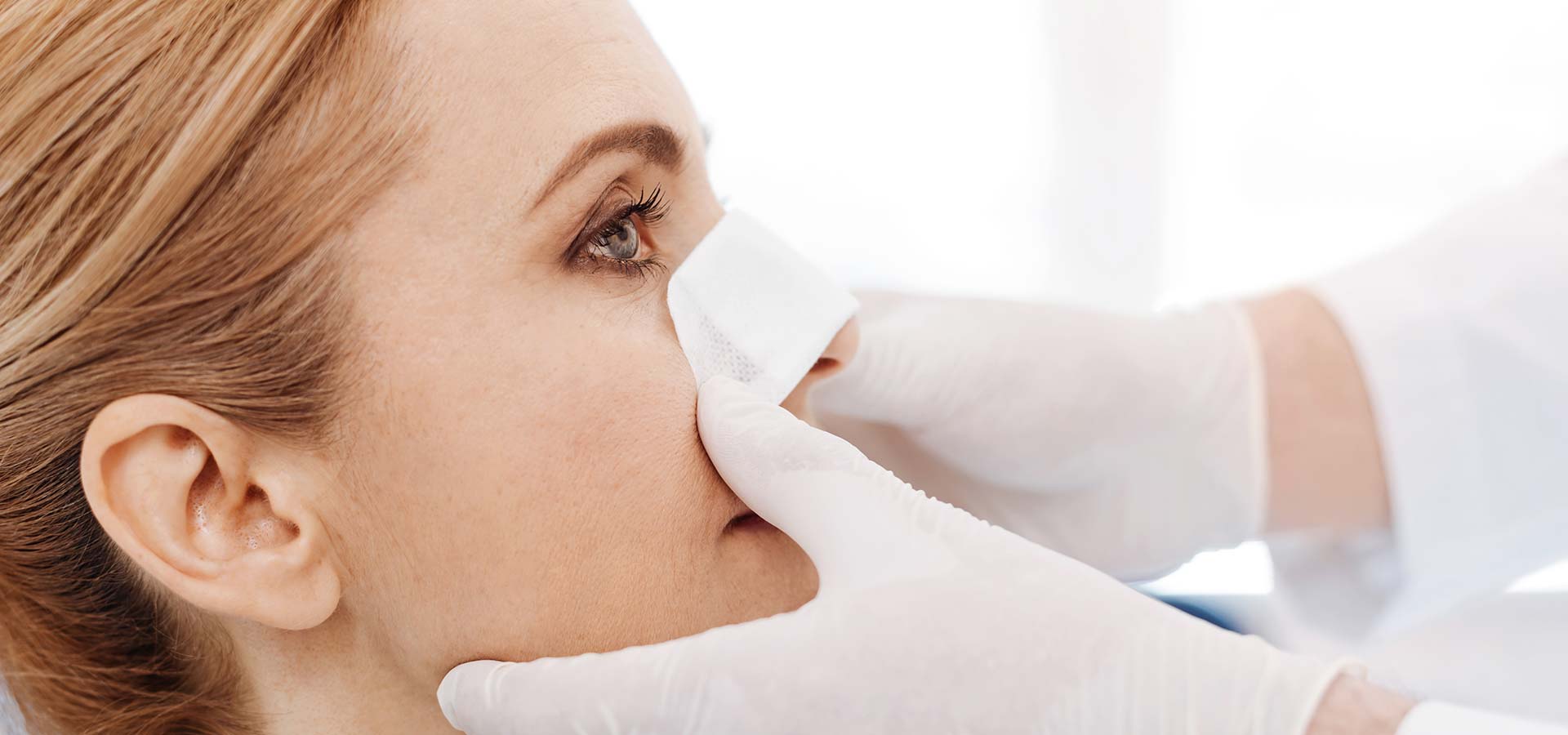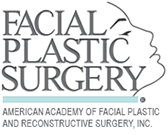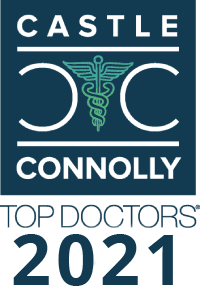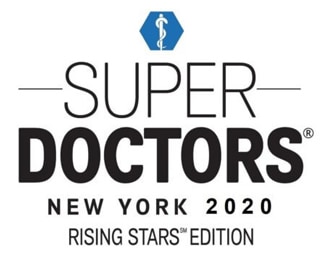Nose Reconstruction
Nose reconstruction is a sinus and nose procedure that is best performed by a surgeon with subspecialty training. The goal of nasal reconstruction is restoring form and function to this intricate and prominent feature of your face. Nose reconstruction may be necessary in a variety of scenarios: nasal fractures, nasal defects from trauma or cancer removal, nasal collapse from underlying medical conditions or substance abuse, and nasal deformity from congenital abnormalities.
Repair of nasal fractures is the most common form of nose repair. In most cases, the repair can be performed, within 10 days of the accident, under local anesthesia during an office visit. Occasionally, treatment of a broken nose is performed in a delayed fashion as a surgical procedure in the operating room. The delayed treatment is similar to a rhinoplasty (nose job).
Skin cancer removal from the nose may result in defects that are small and superficial or massive and full thickness involving the internal nose. Repair of larger defects is particularly deserving of an expert surgeon who can restore the inner lining, the cartilage or bony framework, and the external skin. A variety of techniques such as skin grafts, local skin flaps, forehead flaps, nasolabial flaps, and cartilage grafts may be required in the repair of cancer defects in the nose.
Nose Deformity Surgery
A collapsed nose, also known as a saddle nose deformity, is a devastating deformity that is fortunately rare. The saddle nose deformity is a consequence of loss of support from the septum (the wall inside the nose). Three categories of problems can lead to a collapsed nose: 1. Severe nasal fractures, 2. Underlying medical conditions (e.g. Wegener’s granulomatosis, relapsing polychondritis, and sarcoidosis), and 3. Intra nasal, recreational drug use. The surgical correction involves the use of cartilage or bone grafts to support the nose.
Finally, congenital problems can cause abnormalities and distortions of the nose. Patients with cleft lip develop well-recognized deformities involving the tip of the nose. These deformities are best treated upon completion of the nasal growth. Vascular malformations or hemangiomas can cause nasal distortion or dysfunction and can require a combination of laser and surgical treatment to restore the nose.
Dr. Khosh has extensive experience in nasal reconstruction from any cause. Contact us today to schedule a consultation.
In the case studies listed below, you may see select examples of various nasal repairs.
Case Studies
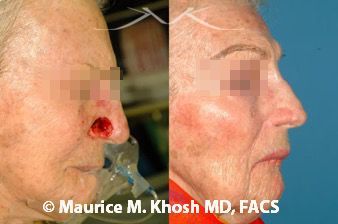
Missing nose skin near the nostril rim
This 84 year-old-woman had basal cell cancer of the nose near the base of right nostril. Following Mohs surgery, there was a 1.5 x 2.0 cm defect of the alar rim.
Cartilage grafting and transfer of skin from the right naso-labial fold, as a two staged surgical procedure, allowed restoration of the shape and function of the nose.
- Patient: 84 year-old-woman with skin cancer of the nose
- Problem: 1.5 x 2.0 cm defect of nasal ala
- Procedure:
- Cartilage graft from the ear
- Two-staged nasolabial skin flap
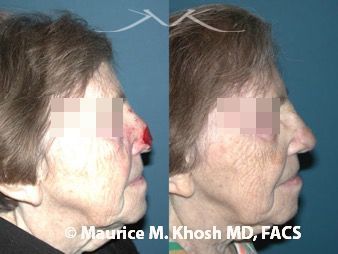
Missing nasal tip skin and cartilage
This 74 year-old-woman had basal cell skin cancer of the tip of her nose. Cancer removal left a defect in the tip of the nose, which extended to inside her nose. Dr. Khosh used cartilage grafts from the ear to restore the projection of the nasal tip, and a skin flap from the forehead (forehead flap) to replace missing skin.
- Patient: 74 year-old-woman with skin cancer of the nose
- Problem: Missing nasal tip skin and cartilage
- Procedure:
- Cartilage graft from the ear
- Two-staged forehead flap
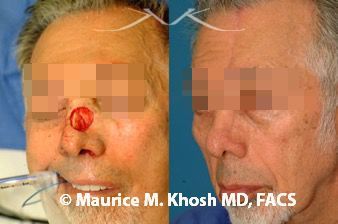
Missing skin in bridge of nose
This 56 year-old-man had a basal cell skin cancer removed by Mohs surgery. He had a 2.5 x 3 cm skin defect in the dorsum of the nose. Skin from the forehead was moved to the nose as a forehead flap to cover the skin defect.
- Patient: 56 year-old-man with skin cancer of nose
- Problem: 2.5 x 3 cm skin defect in nasal dorsum
- Procedure: Two-staged forehead flap
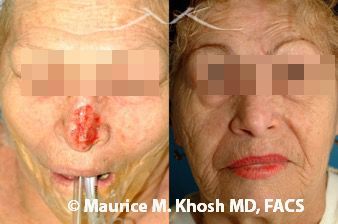
Missing skin in nasal tip and nasal bridge
This 71 year-old-woman had a large skin cancer removed leaving a defect that involved the dorsum and the nasal tip skin. The defect measured 3.0 x 4.0 cm. Dr. Khosh repaired this defect with a flap of skin from the forehead.
- Patient: 71 year-old-woman with skin cancer of nose
- Problem: 3.0 x 4.0 cm skin defect of nasal tip and dorsum
- Procedure: Two-staged forehead flap
Missing skin in sidewall of nose
This 59 year-old-woman had basal cell skin cancer of sidewall of nose. Mohs surgery left a 1.0 cm defect of skin. Dr. Khosh moved the adjacent nasal skin as a bilobed flap to cover the defect.
- Patient: 59 year-old-woman with skin cancer of nose
- Problem: 1.0 cm defect of nasal sidewall
- Procedure: Bilobed flap
Missing skin nasal tip
This 62 year-old-woman had basal cell skin cancer in the nasal tip. Mohs surgery removed the cancer, leaving a 1.0 cm defect in the tip. Dr. Khosh repaired the defect with adjacent skin transfer. The picture shows the early results after one month.
- Patient: 62 year-old-woman with skin cancer of nose
- Problem: 1.0 cm skin defect in the tip
- Procedure: Rotation-advancement flap
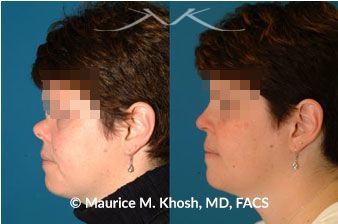
Saddle nose deformity – Nose collapse 1
This 44 year-old-woman developed nasal collapse and saddle nose deformity due to Wegener’s granulomatosis. Once the Wegener’s was safely controlled nasal reconstruction was recommended. Rhinoplasty surgery with use of bone graft from the skull, and cartilage graft form the ear allowed restoration of normal shape and function to the nose.
- Patient: 44 year-old-woman with Wegener’s granulomatosis
- Problem: Nasal collapse- saddle nose deformity
- Procedure:
- Rhinoplasty
- Skull bone graft
- Ear cartilage graft
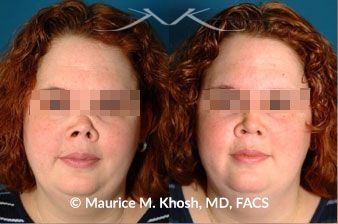
Saddle nose deformity – Nasal collapse 2
This 38 year-old-woman had severe nasal collapse and nasal obstruction due to Wegener’s granulomatosis. Reconstruction was recommended once the medical condition was in remission. During rhinoplasty operation, the structural support of the nose was recreated with bone graft from the skull and cartilage graft from the ear.
- Patient: 38 year-old-woman with Wegener’s granulomatosis
- Problem: Nasal collapse-saddle nose deformity, nasal obstruction
- Procedure:
- Rhinoplasty
- Skull bone graft
- Rib cartilage graft
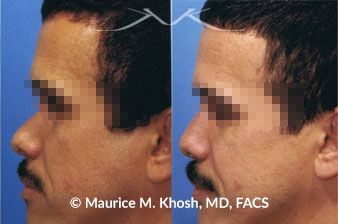
Saddle nose deformity – Nasal collapse 3
This 36 year-old-man was assaulted and sustained a nasal fracture, which resulted in collapse of the bridge of the nose. Dr. Khosh reconstructed this patient’s nose with a bone graft from the skull.
- Patient: 36 year-old-man after assult
- Problem: Collapsed bony basal bridge
- Procedure:
- Rhinopalsty
- Skull bone graft
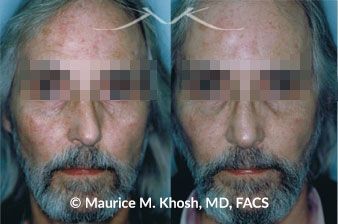
Crooked nose – broken nose 1
This 52 year-old-man had broken his nose causing a severe deviation and difficulty breathing. Dr. Khosh repaired the broken nose and deviated septum to allow normal breathing and straighten the nose.
- Patient: 52 year-old-man with nose fracture
- Problem: Crooked nose, nasal obstruction
- Procedure:
- Rhinoplasty – Repair of nose fracture
- Septoplasty – Correction of deviated septum
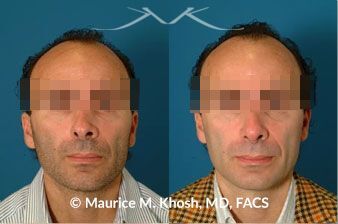
Crooked nose – broken nose 2
This 41 year-old-man had a horse riding accident and suffered a significant nasal fracture. His nose was deformed and his breathing was obstructed. Dr. Khosh performed septoplasty and rhinoplasty to restore the form and function of the nose.
- Patient: 41 year-old-man with nose fracture
- Problem: Deformed nose, nasal obstruction
- Procedure:
- Rhinoplasty – Repair of nose fracture
- Septoplasty – Correction of deviated septum
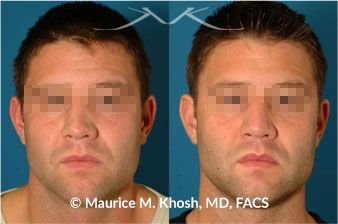
Crooked nose – broken nose 3
This 28 year-old-male suffered a nose fracture from nasal trauma. His nose was deviated to the right side of his face, and he could not breath properly. Dr. Khosh performed septoplasty and rhinoplasty with cartilage grafting to restore the nose.
- Patient: 28 year-old-male with a broken nose
- Problem: Deformed nose, nasal obstruction
- Procedure:
- Rhinoplasty – Repair of nose fracture
- Septoplasty – Correction of deviated septum
Disclaimer: These are actual results for patients of Dr. Maurice Khosh. Plastic and cosmetic surgery results can vary between patients.
Frequently Asked Questions About Nose Reconstruction
-
The more minor treatments such as repair of a broken nose, or repair of a small skin defect on the nose can be performed under local anesthesia during an office procedure. More complex treatments require sedation or general anesthesia in an operating suite.
-
Large skin defects on the lower nose, including the tip or the dorsum, are best repaired with a forehead flap. A forehead flap is a two staged surgical procedure. During the first stage, a flap of forehead skin, that matches the size and configuration of the nose defect, is transferred to the nose to cover the defect. The blood supply for the flap is maintained from a bridge of tissue connected to the medial brow. In the second stage, the base of the flap at the brow is divided and the incisions are closed fully.
-
Nasolabial flaps are ideal for repair of nasal skin defects in the nostril region. Nasolabial flaps can be designed as a single or two-staged procedure. Skin from the fold extending from the corner of the nose to the corner of mouth is transferred to the defect on the nose. In two staged procedures, further inset and refinement of flap is accomplished in second treatment two or three weeks later.
-
The bilobed flap is a surgical procedure that allows repair of a skin defect by transferring tissue from an adjacent site, and closing the newly formed defect in the donor area with a second smaller flap. Bilobed flaps are especially useful in reconstruction of skin defects on the nose that are less than 1 cm wide.
-
Occasionally, nasal deformities are secondary to loss of cartilage framework in the nose. Sometimes, residual cartilage inside the nasal septum can be used to replace such deficit. When adequate cartilage is not present in the septum, cartilage can be harvested from the external ear or the rib. When done properly, there is no visible deficit from such harvesting.
-
Rhinophyma is excess skin thickening in the lower part of the nose due to a chronic skin infection known as Rosacea. The result is progressive enlargement and deformity to the tip of the nose. Treatment involves control of the infection and surgical or laser removal of the excess skin in the tip of the nose.
Related Procedures
Nasal reconstruction results can be augmented with additional treatments including: laser skin resurfacing, septoplasty, or turbinate reduction. Occasionally, additional procedures such as rib cartilage harvest or ear cartilage harvest is necessary in achieving the best outcome in nasal reconstruction.
If you would like to learn more about having nose reconstruction in New York, and about the nose repair techniques that will suit you best, we invite you to meet with Dr. Khosh for a private consultation by calling 212-223-1333, or by scheduling an appointment on line.

Click Here to See Nose Photo Gallery
